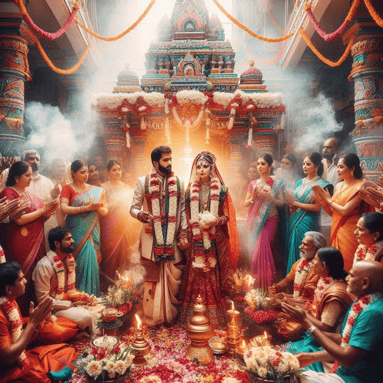Forms Of Marriage under Hindu Law
Prateek Saxena
Delhi Metropolitan Education
This blog is written by Prateek Saxena, a Third-year law student of Delhi Metropolitan Education


Introduction
Marriage is one of the oldest institutions in Hindu society. In ancient times, a daughter was entrusted by her father to a nobleman to become her husband. This tradition has been in existence since the Vedic period. The institution of marriage involves the union of male and female. In Hinduism, the purpose of marriage is considered to be fulfilling one's Dharma and carrying forward the family legacy.
Before the Hindu Marriage Act 1955. Marriage is considered an inseparable bond between the spouses that cannot be broken. According to Manusmritis when a female is married to a male, she remains the wife of her husband for her entire life she can neither remarriage nor divorce and after the death of her husband she is expected to live a simple life with the minimum facility due to the inseparable bond.
However, there was no such obligation for the male. The situation of men was different, they could have more than one wife unlike women there is no such obligation for a man to remarriage after the death of her wife, which leads to disproportion and issues that require to necessary codify Hindu law.
Forms of Hindu marriage
In Hindu religion, marriage is considered the holy union between two people. people of different casts performed different cultures and ceremonies to solemnize marriage in the Vedic period per Manusmriti marriage is differentiated into different categories such as
● Approved form
● Unapproved form
Approved Forms of Marriage
Approved forms of marriage are accepted and recognized by society. These forms of marriage are morally and culturally recognized. the approved forms of marriage consist of
● Brahma,
● Daiva,
● Arsha, and
● Prajapatya.
Brahma
It is widely accepted in Indian society and it is still practiced in Indian culture. In this type of marriage, the daughter is presented to a man chosen by her father to be her husband after being decorated with diamonds and accessories. The man is typically intelligent about the Vedas. Another name for this type of union is Brahma vivah.
Daiva
In this type of marriage, the father offered his daughter to the priest in exchange for a sacrificial payment known as a Dakshina. In this type of union, the father looked for a suitor for his daughter. But the fact that a daughter was offered as Dakshina distinguishes and lessens the significance of this type of marriage from Brahma.
Arsha
In this type of marriage, the daughter is married to a sage in return the father of the bridegroom gives two bulls or cows to the father of the bride. Not like other forms where the father of the bride gives gifts to the bridegroom. However, this kind of marriage was not much appreciated by the community because they believed it was more like a transaction or an exchange. The father's only demands of the bridegroom were that he respect and treat his daughter as his partner in their shared religious commitments.
Prajapatya
This type of marriage is similar to Brahma's marriage. However, there is no concept of kanyadan. In this type of marriage, the father of the bridegroom is the person who searches for the bride. However, the father of the bride put the condition that the couple perform religious obligations. The father's only demands of the bridegroom were that he respect and treat his daughter as his partner in their shared religious commitments.
Unapproved forms of marriage
The unapproved forms of marriage are those marriages that are neither accepted nor recognized by the society. The unapproved forms of marriage are categorized as
● Asura
● Gandharva
● Rakshasa
● Paishacha.
Asura
In an Asura marriage, a girl is given in marriage once the bridegroom bestows on the bride's father all conceivable wealth. For this reason, this type of marriage is the most frowned upon. The bride is traded for money provided by the bridegroom, signifying that she is bought, much like in a business transaction.
Gandharva
In this type of marriage, the consent of the parents is not required because the man and the woman decide to wed each other out of mutual lust. Without following any religious rites or ceremonies or getting their parents' approval, the man and the woman unite physically. Because of this, Gandharva's marriage is distinct and improper.
Rakshasa
This type of marriage was considered the most brutal and unapproved marriage. In this, the bride was abducted and her family was tortured. The husband fought against the bride's family to claim her. This form is considered cruel because it involves the violent kidnapping of brides. This type of marriage is generally done by the Kshtraiyas community.
Paishacha
In this type of marriage, the girl was forced into sexual relations while she was unconscious due to intoxication or due to drugs. Practically it is a rape. Later when the girl regained consciousness was forced to marry the man who violated her. The family of the girl has no other option therefore they have to agree to the marriage.
CONCLUSION
Hinduism is a religion that values marriage as a sacred institution. In India, there are many different kinds of Hindu marriages, and each has its traditions and ceremonies. Rakshasa Vivah is seen as immoral and illegal, whereas Brahma Vivah is revered as the pinnacle of Hindu marriage. Hindu marriages come in a variety of forms, each founded on distinct values including love, respect, affection, and mutual trust. The couple selects the form of marriage that best fits their needs.
References
● https://blog.ipleaders.in/forms-marriage-hindu-religion/
● https://www.saptapadivivah.com/blog/8-types-of-hindu-marriages
● https://testbook.com/static-gk/types-of-hindu-marriages
● https://www.matrimonialsindia.com/blog/types-of-hindu-marriages.htm
